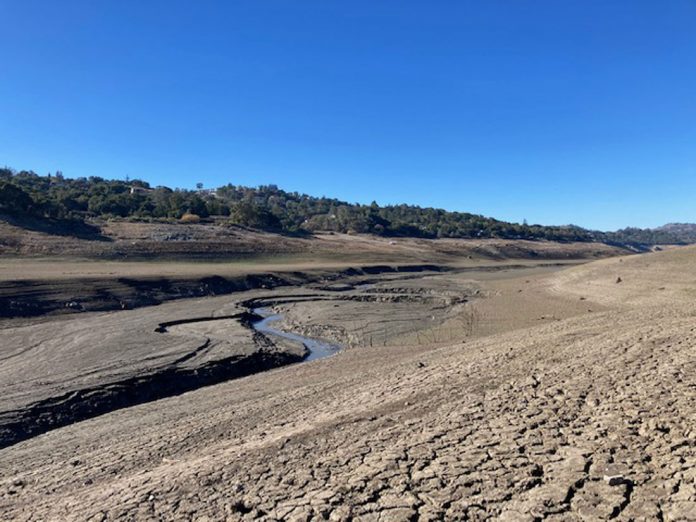The local water district and cities in Santa Clara County are preparing to implement mandatory conservation measures in the face of an ongoing drought that threatens to severely diminish water supplies, according to authorities.
The Valley Water board of directors at the June 9 meeting will consider formally declaring a water shortage emergency condition and imposing mandatory use restrictions on the district’s retailers throughout the county. Specifically, Valley Water recommends that the board require water use reductions of 15 percent from 2019 consumption levels. That’s about 33 percent of water consumption in 2013—the year that preceded the last significant, prolonged drought in California.
Valley Water Board Vice Chair Gary Kremen said in a call with the media Monday that “a couple horrible things are happening” to restrict local water supplies, in addition to the drought that has already led the governor to declare an emergency in 41 counties.
One of the local complications is the fact that Anderson Reservoir in east Morgan Hill—the largest water storage body under Valley Water’s jurisdiction—is only at 3 percent capacity because the dam has been deemed unsafe, Kremen explained. The district this summer will start construction on a seismic retrofit of the dam—a project that will take about 10 years to complete, limiting the reservoir’s storage capacity the whole time.
Furthermore, Kremen said this year’s annual local allocations of water from state and federal programs are only fractions of their normal volumes. The State Water Project is supplying Valley Water with 5% of its normal share of water in 2021, and the annual federal allocation for local agricultural users will not appear at all this year. Valley Water’s expected allocation from the South of Delta Central Valley Project has been reduced from 55% to 25% of normal for 2021.
“It’s a combination of very bad things happening all at the same time,” Kremen said.
If a majority of the Valley Water board approves the mandatory water use reductions on June 9, it will be up to cities and private water retailers throughout Santa Clara County to enforce those cuts. That likely means local restrictions on residents’ water use habits and behaviors, including more limits on outdoor landscape watering, washing vehicles, filling residential swimming pools and water runoff.
In response to the drought and the Valley Water board’s upcoming decision on June 9, the City of Morgan Hill is already preparing to enact additional restrictions on its water customers. Morgan Hill Program Administrator Anthony Eulo said staff will ask the city council on July 16 to declare a “Level 2 Water Supply Shortage” within the city limits.
“A Level 2 declaration does introduce additional water use restrictions that will ensure that local residents and businesses take reasonable steps to address the serious drought facing California,” Eulo said in an email to the Times.
The City of Morgan Hill—and many other cities in the region—made such a declaration in 2015, the last time the state faced a prolonged drought. Restrictions imposed under Morgan Hill’s Level 2 declaration include outdoor watering limited to two days per week; irrigation allowed only before 9am or after 5pm; obligations to repair leaks within 48 hours; no washing cars except at commercial facilities; and limits on filling or refilling swimming pools.
The city ordinance permitting such a declaration gives the city the authority to enforce the new water restrictions with warnings, citations and fines.
Kremen said Valley Water does not currently have the authority to enforce a mandatory water use reduction.
Also at the June 9 meeting, the board will consider voting to urge the Santa Clara County Board of Supervisors to declare an emergency related to the drought. This could give Valley Water more power to enforce water conservation mandates.
Kremen added that water authorities think the biggest area where residents can cut back on their usage is with outdoor watering, and nobody will be asked to reduce essential consumption for drinking, bathing and cooking.
“We’d rather give people incentives not to use water,” said Kremen, pointing to rebates and other programs offered by Valley Water to help homeowners convert their lawns to artificial or drought-resistant features or otherwise cut back on water use.
This year’s unusually dry winter and reservoir conditions throughout the county underscore the foreboding and “dire” water supply conditions that may only get worse, Kremen further explained June 7.
This past winter has been the driest rainy season since 1977, according to Valley Water staff. The district’s total reservoir storage is only at 25 percent of capacity, and the “extreme drought conditions” throughout California have created a competitive market and higher prices for imported water purchases. Valley Water typically relies on imported water for 50% of its water supply.
This winter’s Sierra snowpack—also a key source of water at lower elevations each year—was only 5% of normal, Valley Water staff added.
“If the extreme drought continues, groundwater storage projections for 2022 show levels well below those experienced during the last drought” in 2015, says a Valley Water staff report. “This would greatly increase the risk of subsidence (land sinking), dry wells and associated public health and safety concerns.”
Subsidence, or sinkholes in the valley floor, could result in damage to roads, bridges, homes, pipelines and other infrastructure and property, according to Valley Water staff. Such conditions could occur if local groundwater levels drop significantly without any source to replenish the aquifer.
Under current water usage levels, Valley Water’s total groundwater storage is projected to be about 308,000 acre-feet by the end of this year, if the district is able to secure emergency supplies. Under the same “best case” conditions, projected total storage by the end of 2022 could drop to 238,000 acre-feet—placing the county in a Stage 3 or “severe” water supply shortage.
“In the ‘worst case’ scenario for 2022, groundwater storage is projected to be 138,000 acre-feet, which falls into Stage 5, or the Emergency Stage,” says a Valley Water staff report. “This low level of groundwater storage greatly increases the risks for resumed land subsidence in northern county and wells going dry, particularly in southern county where groundwater is the only potable water supply.”
Visit Valley Water’s website at valleywater.org for incentives, programs and products available to help residents and businesses cut water usage.















